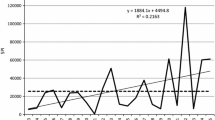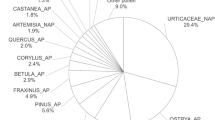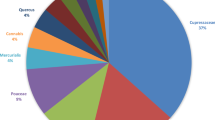Abstract
Although beech (Fagus) pollen are often disregarded, they play an allergological role. This study focused on pollen season (PS) of European beech (Fagus sylvatica L.) and mean yearly temperatures (T) at two climatically different sites (lowlands vs. Alps) in Germany. Pollen sampling was conducted with 7-day recording volumetric spore traps between 1982 and 2014. Both PS parameters (start, peak, length, annual pollen index [PI]) and T were compared in two periods (1982–1991 and 1992–2014), and correlations between PS and T were analysed. At both sites, average PS occurred earlier in the second period. Statistically significant differences were proved at the alpine site in terms of start and peak of the season, and PI. On average, PS in the lowlands was shorter and occurred earlier than in the Alps. As is the case with a lot of temperate tree species, beeches show the masting phenomenon and PI differed greatly among the years. Mast years were much less frequent than non-mast years, and the differences between the pollen sums were significant. Average pollen counts at the alpine site were about three times higher than in the lowlands. At both sites, higher T was significantly correlated with an earlier start and peak of the season, and an increased PI. Trends of T over the years were significantly positive. Temperature increase as a part of climate change may contribute to an earlier occurrence of the flowering season of European beech and to higher airborne pollen concentrations.



Similar content being viewed by others
References
Blomme, K., Tomassen, P., Lapeere, H., Huvenne, W., Bonny, M., Acke, F., et al. (2013). Prevalence of allergic sensitization versus allergic rhinitis symptoms in an unselected population. International Archives of Allergy and Immunology, 160, 200–207.
Bousquet, J., Bachert, C., Canonica, G. W., Casale, T. B., Cruz, A. A., Lockey, R. J., et al. (2009). Unmet needs in severe chronic upper airway disease (SCUAD). The Journal of Allergy and Clinical Immunology, 124, 428–433.
Dahl, Ǻ., Galán, C., Hajkova, L., Pauling, A., Sikoparija, B., Smith, M., & Vokou, D. (2013). The Onset, Course and Intensity of the Pollen Season. In M. Sofiev & K.-C. Bergmann (Eds.), Allergenic pollen: A review of the production, release, distribution and health impacts (pp. 29–70). Dordrecht: Springer.
Dahl, Ǻ., & Strandhede, S.-O. (1996). Predicting the intensity of the birch pollen season. Aerobiologia, 12, 97–106.
D’Amato, G., Bergmann, K. C., Cecchi, L., Annesi-Maesano, I., Sanduzzi, A., Liccardi, G., et al. (2014). Climate change and air pollution. Effects on pollen allergy and other allergic respiratory diseases. Allergo Journal International, 23, 17–23.
Egger, C., Focke, M., Bircher, A. J., Scherer, K., Mothes-Luksch, N., Horak, F., & Valenta, R. (2008). The allergen profile of beech and oak pollen. Clinical and Experimental Allergy, 38(10), 1688–1696.
Eriksson, N. E. (1978). Allergy to pollen from different deciduous trees in Sweden. An investigation with skin tests, provocation tests and the radioallergosorbent test (RAST) in springtime hay fever patients. Allergy, 33(6), 299–309.
Eriksson, N. E., Wihl, J. A., Arrendal, H., & Strandhede, S. O. (1987). Tree pollen allergy. III. Cross reactions based on results from skin prick tests and the RAST in hay fever patients. A multi-centre study. Allergy, 42(3), 205–214.
European Environmental Agency (EEA) (2012). Climate change, impacts and vulnerability in Europe 2012. EEA-Report No 12, Copenhagen.
Galán, C., Emberlin, J., Domínguez, E., Bryant, R. H., & Villamandos, F. (1995). A comparative analysis of daily variations in the Gramineae pollen counts at Córdoba, Spain and London, UK. Grana, 34, 189–198.
Gessler, A., Keitel, C., Kreuzwieser, J., Matyssek, R., Seiler, W., & Rennenberg, H. (2007). Potential risks for European beech (Fagus sylvatica L.) in a changing climate. Trees, 21(1), 1–11.
Hauser, M., Asam, C., Himly, M., Palazzo, P., Voltolini, S., Montanari, C., et al. (2011). Bet v 1-like pollen allergens of multiple Fagales species can sensitize atopic individuals. Clinical and Experimental Allergy, 41(12), 1804–1814.
Hecht, R. (1994). 3. Europäisches Pollenflug-Symposium - Bad Lippspringe - Vorträge und Berichte. In K.-C. Bergmann, Stiftung Deutscher Polleninformationsdienst (Ed.), Pollenbestimmungstechnik, Ergebniswertung und die Herausgabe von Pollenfluginformationen (pp. 21–32). Düsseldorf: Vereinigte Verlagsanstalten GmbH.
Heide, O. M. (1993). Dormancy release in beech buds (Fagus sylvatica) requires both chilling and long days. Physiologia Plantarum, 89, 187–191. doi:10.1111/j.1399-3054.1993.tb01804.x.
Hilton, G. M., & Packham, J. R. (2003). Variation in the masting of common beech (Fagus sylvatica L.) in northern Europe over two centuries (1800–2001). Forestry, 76, 319–328.
Hirst, J. M. (1952). An automatic volumetric spore trap. Annals of Applied Biology, 39, 257–265.
https://bwi.info; 77V1PI_L637mf_0212_bi
Jäger, S., Mandrioli, P., Spieksma, F., Emberlin, J., Hjelmroos, M., Rantio-Lehtimaki, A., et al. (1995). News. Aerobiologia, 11, 69–70.
Jäger, S., Spieksma, E. T. M., & Nolard, N. (1991). Fluctuations and trends in airborne concentrations of some abundant pollen types, monitored at Vienna, Leiden, and Brussels. Grana, 30(2), 309–312.
Kasprzyk, I., Ortyl, B., & Dulska-Jez, A. (2014). Relationships among weather parameters, airborne pollen and seed crops of Fagus and Quercus in Poland. Agricultural and Forest Meteorology, 197, 111–122.
Koenig, W. D., & Ashley, M. V. (2003). Is pollen limited? The answer is blowin’ in the wind. Trends in Ecology & Evolution, 18(4), 157–159.
Körner, C., & Basler, D. (2010). Plant science. Phenology under global warming. Science, 327(5972), 1461–1462.
Kovats, R. S., Valentini, R., Bouwer, L. M., Georgopoulou, E., Jacob, D., Martin, E., Rounsevell, M., & Soussana, J.-F. (2014). Europe. In: Climate Change 2014: Impacts, Adaptation, and Vulnerability. Part B: Regional Aspects. Contribution of Working Group II to the Fifth Assessment Report of the Intergovernmental Panel on Climate Change [Barros, V. R., Field, C. B., Dokken, D. J., Mastrandrea, M. D., Mach, K. J., Bilir, T. E., Chatterjee, M., Ebi, K. L., Estrada, Y. O., Genova, R. C., Girma, B., Kissel, E. S., Levy, A. N., MacCracken, S., Mastrandrea, P. R., & White, L.L. (eds.)]. Cambridge University Press, Cambridge, United Kingdom and New York, NY, USA, pp. 1267–1326.
Maurer, M., & Zuberbier, T. (2007). Undertreatment of rhinitis symptoms in Europe: Findings from a cross-sectional questionnaire survey. Allergy, 62, 1057–1063.
Niedersächsisches Ministerium für Ernährung, Landwirtschaft und Forsten. (1999). Der Hasbruch - Naturkundliche Beschreibung eines norddeutschen Waldes. Schriftenreihe Waldentwicklung in Niedersachsen, Heft 8, S. 43, Wolfenbüttel (in German).
Nilsson, S. G., & Wästljung, U. (1987). Seed predation and cross-pollination in mast-seeding beech (Fagus sylvatica) patches. Ecology, 68, 260–265.
Övergaard, R., Gemmel, P., & Karlsson, M. (2007). Effects of weather conditions on mast year frequency in beech (Fagus sylvatica L.) in Sweden. Forestry, 80, 553–563.
Piovesan, G., & Adams, J. M. (2001). Masting behaviour in beech: linking reproduction and climatic variation. Canadian Journal of Botany, 79, 1039–1047.
Polley, H., & Kroiher, F. (2006). Struktur und regionale Verteilung des Holzvorrates und des potenziellen Rohholzaufkommens in Deutschland im Rahmen der Clusterstudie Forst- und Holzwirtschaft. Arbeitsbericht des Instituts für Waldökologie und Waldinventuren 2006/3. Bundesforschungsanstalt für Forst- und Holzwirtschaft Hamburg, Eberswalde.
Ranta, H., & Satri, P. (2007). Synchronized inter-annual fluctuation of flowering intensity affects the exposure to allergenic tree pollen in North Europe. Grana, 46(4), 274–284.
Satake, A., & Iwasa, Y. (2000). Pollen coupling of forest trees: Forming synchronized and periodic reproduction out of chaos. Journal of Theoretical Biology, 203, 63–84.
Schmidt, W. (2006). Temporal variation in beech masting (Fagus sylvatica L.) in a limestone beech forest (1981–2004). Allgemeine Forst und Jagdzeitung, 177, 9–19. (in German with English summary).
Sykes, M. T., Prentice, I. C., & Cramer, W. (1996). A bioclimatic model for the potential distributions of north European tree species under present and future climates. Journal of Biogeography, 23(2), 203–233.
Wiebicke, K., Schlenvoigt, G., & Jäger, L. (1987). Allergologic-immunochemical study of various tree pollens. I. Characterization of antigen and allergen components in birch, beech, alder, hazel and oak pollens. Allergie und Immunologie (Leipz), 33(3), 181–190.
Ziello, C., Sparks, T. H., Estrella, N., Belmonte, J., Bergmann, K. C., Bucher, E., et al. (2012). Changes to Airborne Pollen Counts across Europe. PLoS One,. doi:10.1371/journal.pone.0034076.
Zuberbier, T., Lötvall, J., Simoens, S., Subramanian, S. V., & Church, M. K. (2014). Economic burden of inadequate management of allergic diseases in the European Union: a GA2LEN review. Allergy, 69, 1275–1279.
Acknowledgments
The authors are grateful to the sponsors of the monitoring site in Oberjoch, by name “Alpenklinik Santa Maria”, Bad Hindelang-Oberjoch, Germany, and “Bad Hindelang Tourismus”, Bad Hindelang, Germany. For critical review and advice, we thank Dr. Mücke, Federal Environment Agency, Berlin, Germany.
Author information
Authors and Affiliations
Corresponding author
Ethics declarations
Conflict of interest
The authors declare that they have no conflict of interest.
Rights and permissions
About this article
Cite this article
Simoleit, A., Wachter, R., Gauger, U. et al. Pollen season of European beech (Fagus sylvatica L.) and temperature trends at two German monitoring sites over a more than 30-year period. Aerobiologia 32, 489–497 (2016). https://doi.org/10.1007/s10453-016-9421-y
Received:
Accepted:
Published:
Issue Date:
DOI: https://doi.org/10.1007/s10453-016-9421-y




